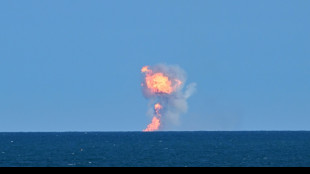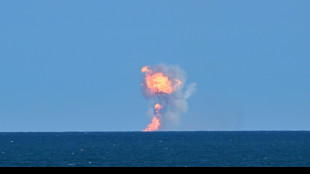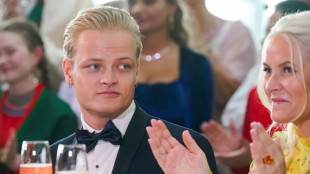
-
 General strike in Greece against cost of living
General strike in Greece against cost of living
-
Magritte painting nets auction record of $121 million

-
 Markets fluctuate as traders weigh geopolitical tensions
Markets fluctuate as traders weigh geopolitical tensions
-
Japanese, Koreans bottom of global love life survey

-
 Japan ramps up tech ambitions with $65 bn for AI, chips
Japan ramps up tech ambitions with $65 bn for AI, chips
-
Taliban govt clearing 'un-Islamic' books from Afghanistan shelves

-
 Asian markets struggle as traders weigh geopolitical tensions
Asian markets struggle as traders weigh geopolitical tensions
-
Iraq holds its first census in nearly 40 years

-
 SpaceX fails to repeat Starship booster catch, as Trump watches on
SpaceX fails to repeat Starship booster catch, as Trump watches on
-
European powers, US seek to censure Iran at UN nuclear watchdog board

-
 SpaceX fails to repeat Starship booster catch, as Trump looks on
SpaceX fails to repeat Starship booster catch, as Trump looks on
-
European stocks fall on Ukraine-Russia fears, US focused on earnings

-
 Trump names China hawk Howard Lutnick commerce secretary
Trump names China hawk Howard Lutnick commerce secretary
-
SpaceX set for Starship's next flight -- with Trump watching

-
 Top-selling daily French daily Ouest-France stops posting on X
Top-selling daily French daily Ouest-France stops posting on X
-
Russian invasion toll on environment $71 billion, Ukraine says

-
 New Botswana leader eyes cannabis, sunshine to lift economy
New Botswana leader eyes cannabis, sunshine to lift economy
-
China's Xi urges 'strategic' ties in talks with Germany's Scholz

-
 COP29 negotiators strive for deal after G20 'marching orders'
COP29 negotiators strive for deal after G20 'marching orders'
-
Walmart lifts full-year forecast after strong Q3

-
 Son of Norwegian princess arrested on suspicion of rape
Son of Norwegian princess arrested on suspicion of rape
-
US lawmaker accuses Azerbaijan in near 'assault' at COP29

-
 Spain royals to visit flood epicentre after chaotic trip: media
Spain royals to visit flood epicentre after chaotic trip: media
-
French farmers step up protests against EU-Mercosur deal

-
 Burst dike leaves Filipino farmers under water
Burst dike leaves Filipino farmers under water
-
Markets rally after US bounce as Nvidia comes into focus

-
 Crisis-hit Thyssenkrupp books another hefty annual loss
Crisis-hit Thyssenkrupp books another hefty annual loss
-
Farmers descend on London to overturn inheritance tax change

-
 Floods strike thousands of houses in northern Philippines
Floods strike thousands of houses in northern Philippines
-
SpaceX set for Starship's next flight, Trump expected to attend

-
 Several children injured in car crash at central China school
Several children injured in car crash at central China school
-
Urban mosquito sparks malaria surge in East Africa

-
 Many children injured after car crashes at central China school: state media
Many children injured after car crashes at central China school: state media
-
Asian markets rally after US bounce as Nvidia comes into focus

-
 Tens of thousands march in New Zealand Maori rights protest
Tens of thousands march in New Zealand Maori rights protest
-
Five takeaways from the G20 summit in Rio

-
 Parts of Great Barrier Reef suffer highest coral mortality on record
Parts of Great Barrier Reef suffer highest coral mortality on record
-
Defiant Lebanese harvest olives in the shadow of war

-
 Divided G20 fails to agree on climate, Ukraine
Divided G20 fails to agree on climate, Ukraine
-
Can the Trump-Musk 'bromance' last?

-
 US to call for Google to sell Chrome browser: report
US to call for Google to sell Chrome browser: report
-
Trump expected to attend next Starship rocket launch: reports

-
 Stocks, dollar hesitant as traders brace for Nvidia earnings
Stocks, dollar hesitant as traders brace for Nvidia earnings
-
Biden in 'historic' pledge for poor nations ahead of Trump return

-
 Tropical storm Sara kills four in Honduras and Nicaragua
Tropical storm Sara kills four in Honduras and Nicaragua
-
Spanish resort to ban new holiday flats in 43 neighbourhoods

-
 Phone documentary details Afghan women's struggle under Taliban govt
Phone documentary details Afghan women's struggle under Taliban govt
-
G20 wrestles with wars, 'turbulence' in run-up to Trump

-
 Stocks, dollar hesitant as traders eye US rate outlook, Nvidia
Stocks, dollar hesitant as traders eye US rate outlook, Nvidia
-
G20 wrestles with wars, climate in run-up to Trump


Moschino unveils first men's collection by Appiolaza in Milan
Luxury Italian fashion house Moschino kicked off the men's catwalk shows at Milan Fashion Week Friday with its first menswear collection under new artistic director Adrian Appiolaza.
Appiolaza, an Argentine designer with a whimsical touch, was appointed creative director of the irreverent, pop-inspired brand in January.
His accession came after the sudden death of his predecessor Davide Renne just 10 days after taking up the post.
Renne had been called to the helm after the departure of Jeremy Scott, who left his decade-long mark on Moschino with his offbeat collections and extravagance.
After a two-year absence from the men's catwalks, the house founded in 1983 by Franco Moschino will also unveil its 2025 women's pre-collection.
A former collaborator of Jonathan Anderson at Spanish luxury brand Loewe, Appiolaza presented his first women's collection for Moschino in Milan in February.
That runway show was all elegance but punctuated with his trademark eccentric touches.
- 'Abrasive irony' -
For that he mined the brand's rich archives, updating iconic pieces to celebrate founder Franco Moschino's legacy and take it to basics.
"I have always admired Franco Moschino's abrasive irony," Appiolaza said in January.
"His were not simply clothes, but a comment on the status quo of the society of his times, built on fabric."
The men's fashion week, dedicated to the 2025 spring-summer collections, will feature a total of 84 events up until Tuesday.
Among those are 24 fashion shows and 52 previews.
Gucci, Prada, Armani, Fendi and Dolce & Gabbana are among many of the venerable labels in attendance.
But there are also some notable no-shows.
Following the departure in March of creative director Pierpaolo Piccioli, Valentino cancelled its men's and haute couture shows scheduled for June.
After 25 years with the famed Roman fashion house, Piccioli was replaced by flamboyant Italian designer Alessandro Michele, who had left Gucci in 2022.
Anglo-Jamaican designer Martine Rose and her eponymous label will make their first appearances in Milan, as will Dunhill, the British brand of Swiss luxury giant Richemont.
Dunhill's showing comes hot on the high heels of its new designer Simon Holloway's triumphant London debut in February.
- One small step for Milan -
Among the newcomers will be Georgian designer David Koma, another London catwalk regular, who chose to launch his men's line at a presentation in Milan on Saturday.
Chinese brand VALLEYOUTH, founded in 2012 by Li Wenjie and Geng Hualiang, will also make its debut, albeit virtually with a digital catwalk on Tuesday.
Long relegated to an afterthought behind womenswear, men's fashion has regained some of its colour as the major brands lend it more prominence.
In the wake of the coronavirus pandemic, sales of Italian men's fashion rebounded by 20.3 percent in 2022.
And menswear sales rose by 4.7 percent to 11.8 billion euros ($12.6 billion) in 2023, according to the employers' federation Sistema Moda Italia.
The Italian fashion sector as a whole saw sales increase by 3.3 percent last year to 102 billion euros.
After strong growth of 8.5 percent in the first half of 2023, activity declined 2.5 percent in the fourth quarter against a backdrop of high geopolitical tensions.
This downward trend continued into the first two months of 2024, with a drop of three percent compared to January and February 2023, according to Italian Chamber of Fashion president Carlo Capasa.
This decline was principally driven by the weakness of the Italian market, Capasa added.
H.Cho--CPN
